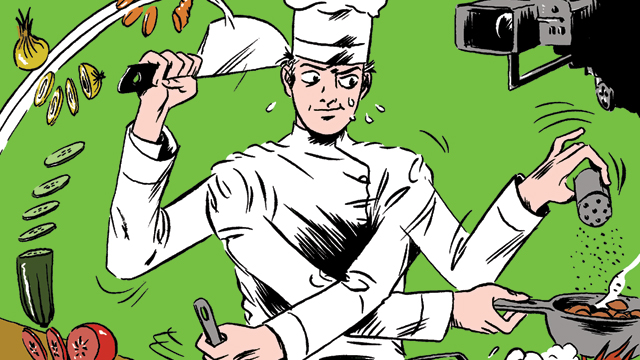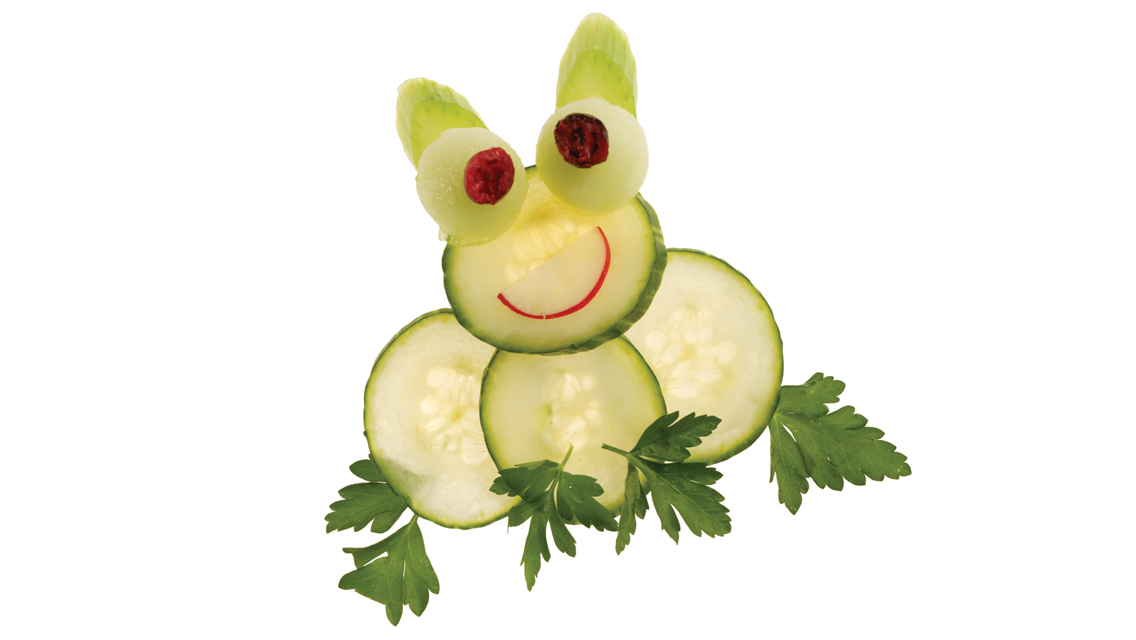It’s popular lately to think about brains and evolution, and what skills or traits humans have evolved over the millennia that serve us well, or don’t serve us well, in our modern conditions. For instance, we’re very good at being afraid of snakes, and less good at intuitive statistical analysis (something to ponder the next time you’re walking through Macy’s and startle at a snakeskin belt fallen beneath a rack of bathrobes). And I’d argue that there’s no greater cultural manifestation of that which we emotionally understand, and intellectually miss by a country mile, than the television program Iron Chef. And even more so, Iron Chef America.
Iron Chef! Everything about it seemingly makes sense. Contestants start with raw ingredients, with nothing but the naked, unadorned possibility of success or failure: mussels, ox-tails, squid! Contestants have an hour to prepare a dish, the selfsame, single hour that we, the viewer, have allocated to this experience. Then, at the end, we can taste — really, almost, practically taste — the dishes, so informed are we in the details of their manufacture, and so familiar are we with the building blocks of each dish, with thyme, with custard, with things fried or wrapped in phyllo dough.
At the end, we can also feel — really feel, with chemical tingles lighting up the nuclei of our amygdala — the social humiliation and personal triumph of the winning and losing contestants.
But as we watch these entertaining, diverting hours, as we endure the judges’ awful, stinging comments, as well as their banal, wonderful praise, we lose track of the fact that we have to be rather evolved not to let Iron Chef and its ilk entirely ruin our food lives.
Reality Check
Not that there’s anything wrong with Iron Chef, providing you understand editing and the nature of entertainment. Editing, well, that’s self-explanatory: The boring bits go out the window. There’s no finding a parking spot in front of the grocery store, no standing in front of a row of canned tomatoes while trying to recall whether it’s worth paying a premium for whole tomatoes, or whether diced or crushed tomatoes will suffice. There’s no waiting in line behind someone who’s using his telephone to show the cashier his vacation photos. There’s no putting the tomatoes in the trunk, no carrying the tomatoes into the house — all of this before one even gets to Step 1 of making a lasagna. On reality television, the real-life, real-time of reality goes away. Because reality is too real to sustain interest.
The human tendency to overlook and underappreciate the power of the editing process can be pinned as the source of many modern problems: You see the marathon runner’s burst over the finish line, but not the 20 years of prior early-to-beds, refused dinner invitations and laundry. And let’s not even mention how many relationships have been dashed by the expectations created by movie love scenes, which conveniently skip over all the relationship stuff about who gets stuck cleaning the bathroom the following Monday, or who has to call the nursing home to see how Dad is doing.
The editing of food-prep footage on Iron Chef, and on every single TV food show, is the mother of unrealistic expectations. If you think you can shop for and prepare a lasagna, a pot roast or a crawfish pie in an hour (because that’s how they do it on television), you’re sorely mistaken.
If you feel like a failure because you can’t, then you’re setting yourself up for a lousy food life, a life of takeout, reheating, and pressing your nose up against the TV screen watching other people eating well. With the boring bits edited out, of course.
Miracle Workers
And how about those food-show judges? The scathing comments, the belittling remarks, the dismissive put-downs. How many people avoid cooking from the fear that their best attempts will be greeted with insults and snarls? And how about those ingredients? You do know the rules of Iron Chef, don’t you? The
ingredients aren’t quite the shock they seem to be. The contestants are provided with a longer list of ingredients, usually five, one of which will be the final main ingredient. So the chefs come in with at least five possible menus in mind, and then execute one of them — impressive, certainly, but not miraculous. Still, the impression remains that these chefs are nothing less than miraculous.
The idea that cooking is a feat beyond the ability of average people remains, too. If, however, you actually know what the Iron Chefs are doing — walking into a room with recipes in mind, and fitting what they find into those recipes — it’s much less entertaining. Because that’s what people have done for tens of thousands of years to feed themselves; it’s called a cuisine (something I touched on in my January column).
No Editing Required
I thought about this great difference — between cuisine as we Americans see it on television, and cuisine as a culture lives it — the other day when I was eating boiled potatoes and garlic in a tent. This meal was courtesy of my friend Bill, a transplanted New Orleans native who celebrates his heritage with a once-a-year blowout of a crawfish boil, in which crawdads are boiled with premixed seasoning, segments of corn on the cob, skin-on potatoes, lemons, heads of garlic, smoked sausage and onions. It’s a meal you eat with your hands, ripping the tails from the crawdads, squeezing boiled garlic on potatoes, and, of course, nibbling corn on the cob. It’s always one of the highlights of my year, each element sweet, fresh, earthy, or sea-breeze-capturing, in turn. The whole of it saline and in the end absolutely soul-satisfying.
This year I noticed for the first time the boiling aspect of it — and boiling is not typically seen as the height of culinary technique. Boiling, in fact, is the smallest part of a white-tablecloth-chef’s repertoire. Chefs do parboil vegetables now and then, but they then spend more time unboiling them (that is, submerging them in ice water).
Boiling is about as brutal and unforgiving a technique as there is. Boiling is for peasants and laborers. (Chefs sauté.) But the garlic, potato, lemon, onion and corn technique of a crawdad boil is nothing short of genius.
Try it! You just put everything in a pot, and add shrimp, crawfish or plain old fish fillets toward the end (see recipe at right). And it’s genius because of two things it doesn’t require: editing, and the supreme secret knowledge that only people on television possess and that you never can.
Making a simple dish like boiled crawdads won’t make you an Iron Chef, but it will make you something even more valuable and admirable in my view — a home cook.
Shrimp or Fish Boil
If you prefer to use live crawfish (also called crawdads) instead of shrimp or fish, check with your local fish market to see if it carries them. If not, there are numerous Web retailers that will overnight them to you. For the following recipe, which serves four, use 1½ pounds of crawfish.
- 1 lemon, quartered
- 5 tbs. Creole or Cajun seasoning mix (Zatarain’s or Old Bay work well), plus a little more for sprinkling on the fish at the end
- 1 head garlic, the top inch sliced off to reveal individual cloves
- 8 small (golf-ball size) edible-jacket potatoes such as red potatoes or larger potatoes cut into 2-inch segments
- 4 ears of corn, shucked and halved
- 1½ pounds large shrimp in shell, or a pound to 1½ pounds of firm fish such as salmon or lake trout
Boil a gallon of water (16 cups) in a large pot, take lemon quarters in your hand and squeeze into water, then throw the lemons in. Add seasoning. (If using salt-free seasoning, add a tablespoon of salt or so, or plan on salting when eating.) Add remaining ingredients, except fish and corn. Boil, then simmer, until potatoes are almost tender, 10 to 12 minutes. Add corn, cook until tender, about three minutes. Add shrimp or fish, and sprinkle with additional seasoning, and cook until shrimp turns pink and is cooked through, or fish is cooked through, four to eight minutes.
Serve, with hot sauce or additional lemon quarters if desired.


